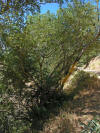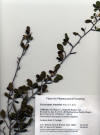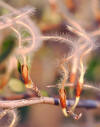|
Cercocarpus
betuloides |
Cercocarpus
betuloides |
 
Cercocarpus
betuloides |
|
Cercocarpus
betuloides |
Cercocarpus
betuloides
|
Cercocarpus intricatus |
Cercocarpus intricatus
|
Cercocarpus intricatus |
Cercocarpus ledifolius
|
|
Cercocarpus ledifolius
|
  Cercocarpus ledifolius Ruby Mts. Nevada looking east towards Utah, 9 Aug 2008. |
Cercocarpus ledifolius |
|
Cercocarpus minutiflorus
|
Cercocarpus montanus |
|
|
Trees and Shrubs of Kern County (Dec 2012) Key to Cercocarpus
1. Leaves wedge-shaped
and entire in lower half , curved and
1. Leaves gradually
narrowed to base and apex from mid region,
2. Trees with wide
spreading branches; leaves 2–5 cm long, rolled under
2. Intricately
branched shrubs; leaves 0.5–1.5 cm long , tightly
Cercocarpus betuloides Nuttall 1840 var. betuloides [Included by some under a broader species concept, C. montanus Rafinesque 1832]. Mountain mahogany. Commonly an evergreen large shrub but also a tree as seen along Rancheria Road in Kern Co., to 6 m; stems erect from an underground burl, bark whitish gray, smooth; leaves evergreen, alternate, generally elliptical in outline, wedge-like in lower half with entire margins, curved and tapered to a rounded apex, toothed (crenulate) along margins in upper half, with conspicuous parallel veins impressed on the upper surface, raised on the lower surface. Flowers Mar–May, inconspicuous, appearing as tiny green cups, usually several flowers developing together on short separate stalks (pedicels), white silky hairy when young, aging less hairy and reddish; fruit developing long hairy whips or tails (from styles that grow longer) arising from the pericarpium body (achene) that appears to be dispersed from splitting of the surrounding floral tube, just halfway down one side (fruit a tryma). Chaparral and woodlands below 8,000 ft, southern Oregon, California to San Pedro Mártir and western Arizona. Type from mountains near Santa Barbara, CA. Birch leaf mahogany chaparral recognized in MCV2 when >30% relative cover with no other shrub species exceeding it in cover, or with Arctostaphylos glauca equal in cover, or between 30% and 60% relative cover in the shrub canopy with Eriogonum fasciculatum having the same cover, or ≥30% relative cover with other shrubs having the same cover. Kern Co.: Southern Sierra Nevada especially along the western slopes, Kern Plateau, Kern River Canyon, Piute Mts., Breckenridge Mts., Tehachapi Mts., San Emigdio Range, 609–1676 m (CCH) The species is similar to C. montanus that differs in its deciduous habit, occurring in South Dakota, Montana, Wyoming, Colorado, Utah, New Mexico, western Oklahoma, Utah, eastern Nevada, and Arizona south to mainland Mexico. In Kern County, C. betuoloides Cercocarpus intricatus S. Watson 1875[C. ledifolius var. intricatus (S. Watson) M.E. Jones 1891]. Little-leaf mountain mahogany. Densely branched evergreen shrub to 3 m; branches very rigid; leaves short with parallel margins, ~3× longer than wide, margins tightly rolled (revolute) to the mid region; flowers Mar-–Apr, on shorter pedicels than preceding, or pedicels obsolete; fruit similar to preceding. Primarily grows out of limestone crevices in the pinyon-juniper forest/ woodland deserts from eastern California to southwestern Colorado. Type from American Fork Canyon, Utah. Small leaf mountain mahogany scrub recognized in MCV2 when >55% relative cover in the shrub canopy (but outside Kern Co.). Kern Co.: “Occasional in the sparse Jeffrey pine forest in the Bartolas County of the southern Kern Plateau” (Twisselmann), and “along the south rim of the Kern Plateau overlooking South Fork Valley, Bartolas section, Domeland Wilderness” (CCH: Shevock). Cercocarpus ledifolius Nuttall 1840 var. ledifolius and var. intermontanus N.H. Holmgren 1987. Desert mountain mahogany, Curl leaf mountain mahogany. Evergreen shrub or commonly a tree to 9 m; bark whitish gray, or reddish brown and furrowed; leaves narrowly elliptic, tapering at both ends, 3–5× longer than wide, 2–5 cm, curved downwards across the upper surface and tightly revolute at margins (but not to the mid region), green above, yellowish to white below; flowering Apr–Jun. Common on ridges and dry slopes in the high deserts, from Washington to Montana to Colorado, south to Utah, Nevada, and west to California. JM2 indicates that var. ledifolius is uncommon in California. Type from “Rocky Mountains in alpine situations on the summits of the hills of Bear River [Idaho]. Curl leaf mountain mahogany scrub recognized in MCV2 when “>50% relative cover in the tall shrub or short tee canopy.” Kern Co.: The southern Sierra Nevada plants correspond geographically to Kern plants from the Owens Peak region, and along the western slopes of the Mojave to Piute Mt. Plants from the Tehachapi and San Emigdio Canyon seem to correspond to the more widely distributed var. intermontanus, but identified var. ledifolius in CCH. Because of this discrepancy, the varieties are treated together here.
|
||


















